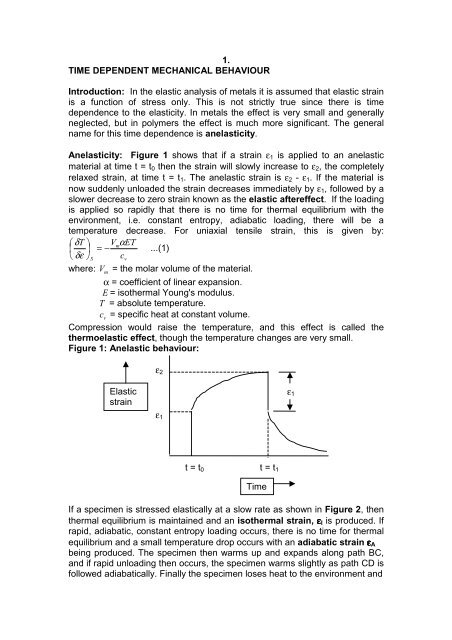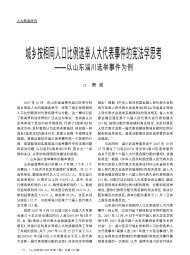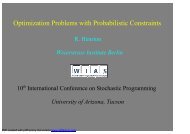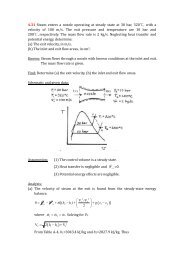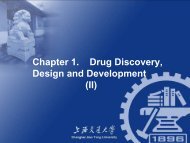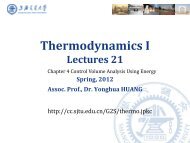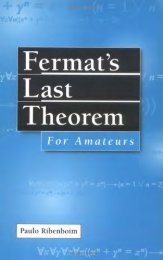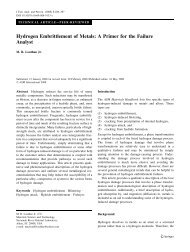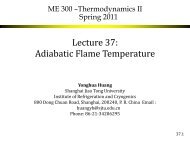1. TIME DEPENDENT MECHANICAL BEHAVIOUR Introduction ... - CC
1. TIME DEPENDENT MECHANICAL BEHAVIOUR Introduction ... - CC
1. TIME DEPENDENT MECHANICAL BEHAVIOUR Introduction ... - CC
- No tags were found...
Create successful ePaper yourself
Turn your PDF publications into a flip-book with our unique Google optimized e-Paper software.
<strong>1.</strong><strong>TIME</strong> <strong>DEPENDENT</strong> <strong>MECHANICAL</strong> <strong>BEHAVIOUR</strong><strong>Introduction</strong>: In the elastic analysis of metals it is assumed that elastic strainis a function of stress only. This is not strictly true since there is timedependence to the elasticity. In metals the effect is very small and generallyneglected, but in polymers the effect is much more significant. The generalname for this time dependence is anelasticity.Anelasticity: Figure 1 shows that if a strain ε 1 is applied to an anelasticmaterial at time t = t 0 then the strain will slowly increase to ε 2 , the completelyrelaxed strain, at time t = t 1 . The anelastic strain is ε 2 - ε 1 . If the material isnow suddenly unloaded the strain decreases immediately by ε 1 , followed by aslower decrease to zero strain known as the elastic aftereffect. If the loadingis applied so rapidly that there is no time for thermal equilibrium with theenvironment, i.e. constant entropy, adiabatic loading, there will be atemperature decrease. For uniaxial tensile strain, this is given by: δT VmαET = − ...(1) δε Scvwhere: Vm= the molar volume of the material.α = coefficient of linear expansion.E = isothermal Young's modulus.T = absolute temperature.cv= specific heat at constant volume.Compression would raise the temperature, and this effect is called thethermoelastic effect, though the temperature changes are very small.Figure 1: Anelastic behaviour:Elasticstrainε 2ε 1ε 1t = t 0 t = t 1TimeIf a specimen is stressed elastically at a slow rate as shown in Figure 2, thenthermal equilibrium is maintained and an isothermal strain, ε I is produced. Ifrapid, adiabatic, constant entropy loading occurs, there is no time for thermalequilibrium and a small temperature drop occurs with an adiabatic strain ε Abeing produced. The specimen then warms up and expands along path BC,and if rapid unloading then occurs, the specimen warms slightly as path CD isfollowed adiabatically. Finally the specimen loses heat to the environment and
2.cools and contracts along path DA. This results in a closed mechanicalhysteresis loop. In practice if stressing is continuous, a more lenticularshaped loop is produced as shown in Figure 3.Figure 2: Adiabatic and Isothermal stress strain curves:B CStressAdiabatic LineIsothermal LineA D ε A ε IStrainFigure 3: Hysteresis Loop from continuous cyclic loading.StressStrainThe area of a hysteresis loop is small, especially for metals, but withcontinuous rapid vibration, the energy loss per cycle is given by the areawithin the loop. This is because the area under a stress strain curve1represents elastic strain energy per unit volume, i.e. U = οε ...(2). From an2engineering point of view, the energy loss leads to heating, damping ofvibrations and also contributes to friction, particularly in materials like rubber.Mechanical Hysteresis, Internal Friction and Damping: The area of thehysteresis loop depends on frequency of cycling. For very low frequency,isothermal cycling the area is low, and area is also low for very fast adiabaticcycling. At some intermediate frequency the area will be a maximum.Vibrational energy in crystalline solids may be dissipated by severalmechanisms, other than the thermoelastic effect. These include:(i) Stress induced ordering of solute atoms.
(ii) Grain boundary sliding.(iii) Dislocation movements.(iv) Bond rotation in polymers.(v) Moisture absorption in polymers.3.The generic name for these energy dissipating mechanisms is InternalFriction, and precision measurements of this parameter can give informationon structure changes such as precipitation, diffusion etc. If a bar of material isset into vibration with an initial amplitude A0, after a time 't' the amplitude will−βthave decayed to A t, where At= A 0e ...(3), where β is the attenuationcoefficient. The ratio of successive amplitudes enables the logarithmicAndecrement δ to be found from: δ = ln ...(4)An+ 1The strain lags behind the stress by a phase angle α, which is related to thelogarithmic decrement by: δ = πα ...(5)True anelastic behaviour is independent of amplitude of vibration, but otherenergy dissipating mechanisms may not be. For Forced Vibrations, thespecimen is driven at constant amplitude, and a measure of the internal∆Wfriction is given by: δ = ...(5), where ∆ W is the energy loss per cycle, or2Whysteresis loop area, and 2Wis the total energy per cycle. For a fixed amountof energy per cycle, the maximum amplitude of vibration occurs at theresonant frequency. Internal friction studies are carried out at low stress andstrain levels (0.05 to 0.5 MNm -2 ), while energy dissipation at higher stress andstrain levels is generally referred to as damping. In engineering terms, a highDamping Capacity would help to reduce machinery noise, suppressvibrations in machinery, reduce the amplitude of resonant vibrations andreduce likelihood of fatigue. Table 1 shows the damping capacity of someengineering materials at different stress levels. It can be seen that cast ironmakes a better energy absorbing material than other alloys due to the inabilityof graphite flakes in the structure to transmit elastic waves.Table 1: Damping Capacity of Materials:MaterialSpecific Damping Capacity ∆W / W31 MNm -2 46 MNm -2 77 MNm -2Carbon steel (0.1%) 2.28 2.78 4.16Ni-Cr steel, quenched/tempered 0.38 0.49 0.7012% stainless steel 8.0 8.0 8.018-8 stainless steel 0.76 <strong>1.</strong>16 3.8Cast iron 28.0 40.0Yellow brass 0.50 0.86


